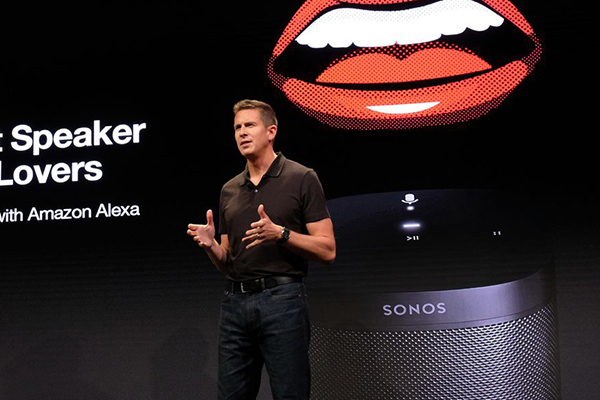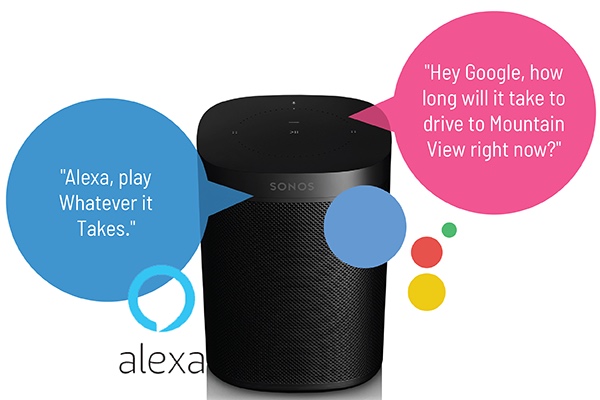Sonos CEO Patrick Spence Hedges on Whether Google Assistant Will Be Supported in 2018

In a podcast interview by The Verge’s Nilay Patel, Sonos CEO Patrick Spence declined to confirm that the Sonos One smart speaker would support Google Assistant in 2018. The support of multiple voice assistants by Sonos devices has been a cornerstone of the company’s strategy as it has moved into smart speakers. Sonos user experience executive Mieko Kusano told The Verge in another interview that:
“A home sound system for us means shared. We believe many different people will want to use it…We’ve already been here before with phones. Sharing your home sound system maybe one person has an Android phone, the other one has an iOS phone. We never said, ‘we are only going to support iOS and the whole household please go iOS,’ or ‘we are only going to support apps on Android, the whole house should go Android.’ We just don’t believe it’s very consumer friendly [to support only a single voice assistant].
Spence Won’t Confirm Google Assistant Will Arrive on Sonos One in 2018
The Verge article by Chris Welch points out that multi-assistant support was a core element of the company’s 2017 smart speaker product launch and there was a clear statement that Google Assistant would join Amazon’s Alexa in 2018.
“Last year when the company unveiled the Sonos One (its first speaker with built-in microphones designed for voice control), it said that Google Assistant would be joining Alexa on the device sometime in 2018. Its customer support Twitter account has also reiterated that ‘Google Assistant is coming to Sonos this year.'”
Hello, Google Assistant is coming to Sonos this year, stay tuned.
— Sonos Support Team (@SonosSupport) April 24, 2018
“But Sonos CEO Patrick Spence didn’t seem so firm on that timeline. He declined — twice — to confirm whether Assistant integration will actually launch to customers this year, saying only ‘we’re working on it.’”
Great Idea That is Complex to Implement
 The concept is pretty straightforward — allow multiple voice assistants to operate on a singe device — but the implementation is more complex than many people anticipate. First, you have the permissions. Voicebot wrote earlier about rumors that Sonos was only able to get Google to agree to Assistant integration by using its patent portfolio, and Google’s presumed violations, as negotiating leverage. Previously, Google had refused overtures by device manufacturers to allow Assistant to reside alongside Alexa.
The concept is pretty straightforward — allow multiple voice assistants to operate on a singe device — but the implementation is more complex than many people anticipate. First, you have the permissions. Voicebot wrote earlier about rumors that Sonos was only able to get Google to agree to Assistant integration by using its patent portfolio, and Google’s presumed violations, as negotiating leverage. Previously, Google had refused overtures by device manufacturers to allow Assistant to reside alongside Alexa.
After you get permission, there are then design choices. Will the user be required to set a default assistant and only open the other by changing the default? Will that change be voice enabled or require manual intervention? Will both voice assistants be active all of the time and listening for their respective wake words? If so, what if they both think they are being invoked at the same time? How will that conflict be resolved?
Then there is the technical implementation. None of these are easy tasks. You have already seen that it can be difficult to implement a single voice assistant into a smart speaker. A recent study by Vocalize.ai suggested that Sonos One’s sensitivity to background noise interference is so significant that it resembles severe hearing loss in humans. Sonos almost certainly needs to address that problem to ensure users have a good experience and can get the smart speaker to wake up even when there is moderate background noise, a common scenario in the home. Then it needs to onboard another assistant and determine how it will work in a multi-platform, multi-user household. No wonder Mr. Spence wouldn’t commit. There are many things that can go wrong.
This situation surfaces the fact that these devices and the user experience are highly complex. We often don’t notice it because the cylinder arrives and it just works out of the box. The tough engineering choices were already made and tested. Many people probably thought adding one more voice assistant to a functioning smart speaker would require half the effort of the first. My guess is that the additional effort is likely 2-3 times more.
Will Sonos One Be the First Multi-Voice-Assistant Device?
I am eagerly anticipating the Sonos One with both voice assistants simply because I want to experience the implementation and understand the design and engineering choices. It will likely be the first example of how multiple voice assistants can be accessed through a single device. Or, we may see another conclusion that Sonos introduces a smart speaker that simply adds Google Assistant without Alexa. That would also be a telling signal about how complex this exercise can be.
Sonos One, Eufy Genie and Amazon Echo Dot Exhibit Characteristics of Hearing Loss in New Study
Sonos Patent Portfolio Used to Persuade Google to Allow a Multi-Assistant Device








